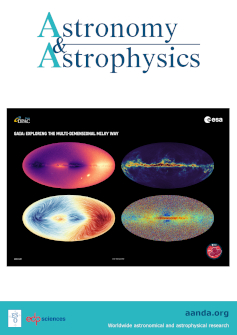法斯特
IF 5.4
2区 物理与天体物理
Q1 ASTRONOMY & ASTROPHYSICS
引用次数: 0
摘要
背景行星在年轻恒星周围的星盘中形成。行星形成过程的开始时间仍是一个未决问题。环状亚结构(如星环和星盘中的空隙)与行星的形成息息相关,因此它们的存在与否通常被用来研究这一过程的开始时间。目前的观测结果表明,原恒星周围数量有限的星盘呈现出环状亚结构,所有这些星盘都处于一级阶段。在这些星源中,大部分都没有观测到亚结构的特征,这可能表明亚结构出现得较晚,但也可能是由于这些星盘的光学厚度较厚造成的。为了缓解光学深度的问题,我们利用较长波长的观测数据研究了一个非常年轻的0级盘内的亚结构,其特点是倾角较低。我们使用分辨率为 7 au 的 3 mm ALMA 观测数据追踪尘埃发射,以寻找深嵌在 0 级原恒星 Oph A SM1 周围的圆盘中环状亚结构的证据。观测结果显示,一个几乎面朝上的圆盘(倾角∼ 16°)一直延伸到 40 au。径向强度曲线在 30 au 附近明显偏离了平滑曲线,我们将其解释为在 28 au 处存在一个缺口,或者在 34 au 处存在一个高斯宽度分别为 au 和 au 的环。最重要的是,在可能的间隙或环的位置上的 3 毫米发射被确定为光学稀薄的,排除了强度曲线上的这一特征是由于发射是光学厚的这一可能性。与进化程度较高的 I 类和 II 类磁盘中的环状子结构相似的环状子结构确实可能存在于 0 类阶段,这比之前的观测结果所显示的时间要早。为了更好地确定嵌入阶段亚结构的出现时间,显然需要对嵌入盘进行类似的观测,以缓解高光学深度问题。本文章由计算机程序翻译,如有差异,请以英文原文为准。
FAUST
Context. Planets form in the disks surrounding young stars. The time at which the planet formation process begins is still an open question. Annular substructures such as rings and gaps in disks are intertwined with planet formation, and thus their presence or absence is commonly used to investigate the onset of this process.Aims. Current observations show that a limited number of disks surrounding protostars exhibit annular substructures, all of them in the Class I stage. The lack of observed features in most of these sources may indicate a late emergence of substructures, but it could also be an artifact of these disks being optically thick. To mitigate the problem of optical depth, we investigated substructures within a very young Class 0 disk characterized by low inclination using observations at longer wavelengths.Methods. We used 3 mm ALMA observations tracing dust emission at a resolution of 7 au to search for evidence of annular substructures in the disk around the deeply embedded Class 0 protostar Oph A SM1.Results. The observations reveal a nearly face-on disk (inclination ∼ 16°) extending up to 40 au. The radial intensity profile shows a clear deviation from a smooth profile near 30 au, which we interpret as the presence of either a gap at 28 au or a ring at 34 au with Gaussian widths of au and au, respectively. Crucially, the 3 mm emission at the location of the possible gap or ring is determined to be optically thin, precluding the possibility that this feature in the intensity profile is due to the emission being optically thick.Conclusions. Annular substructures resembling those in the more evolved Class I and II disks could indeed be present in the Class 0 stage, which is earlier than suggested by previous observations. Similar observations of embedded disks in which the high-optical-depth problem can be mitigated are clearly needed to better constrain the onset of substructures in the embedded stages.
求助全文
通过发布文献求助,成功后即可免费获取论文全文。
去求助
来源期刊

Astronomy & Astrophysics
地学天文-天文与天体物理
CiteScore
10.20
自引率
27.70%
发文量
2105
审稿时长
1-2 weeks
期刊介绍:
Astronomy & Astrophysics is an international Journal that publishes papers on all aspects of astronomy and astrophysics (theoretical, observational, and instrumental) independently of the techniques used to obtain the results.
 求助内容:
求助内容: 应助结果提醒方式:
应助结果提醒方式:


